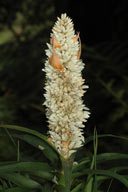In Flower This Week
A news sheet prepared by a Gardens' volunteer.
Numbers before each plant refer to temporary IFTW labels in the gardens.
Numbers in square brackets [ ] refer to garden bed Sections. Plants in flower are in bold type.
View past issues of 'In Flower This Week'.
15 October 2014
Richea dracophylla click for larger image |
Today we walk along part of the Main Path to be rewarded by many plants in flower.
- As you leave the VIC look to your left to see in a pot the extravagant bloom of Chorizema cordatum [Section 221] or Heart-leaved Flame Pea. It is a showy plant with vivid pink and orange flowers on a weeping shrub with bright green prickly foliage. It grows naturally in the moist south western parts of Western Australia.
- On your left is Alyogyne huegelii ‘West Coast Gem’ [Section 210], with clear purple ‘hibiscus’ style flowers which open for a short period only but are prolific. The bush is medium sized with coarse foliage.
- Also on your left is Hibbertia empetrifolia [Section 210] with masses of gold coin flowers on the wiry foliage. This small scrambling shrub is also known as Tangled Guinea-flower and is native to south-eastern Australia.
- As you cross the bridge notice on your right Richea dracophylla [Section 66], with creamy spires of flower and spiky foliage. This plant is endemic to Tasmania.
- Further on your left as you skirt the café is Grevillea sericea subsp. sericea [Section 244], or Silky Grevillea, an open bush with white frothy spider flowers.It is native to the central coast of NSW.
- On the left is Libertia paniculata [Section 131] with iris-like foliage and white branched flowers. It is commonly called the Branching Grass Flag. Libertia is named after Anne-Marie Libert, a Belgian botanist. This plant is native to the east coast of Australia.
- As you veer right down towards the Crosbie Morrison building you see on your left a very large bush of Grevillea ‘Bonfire’ [Section 240], with bright red waxy blooms on dark green linear foliage. This plant is a hybrid between G. johnsonii and G. wilsonii.
- Philotheca myoporoides [Section 240] has masses of white flowers with pink buds. Also called Long-leaf Wax Flower, the species is endemic to south-eastern Australia.
- Isopogon anethifolius [Section 240] has vigorous upright linear foliage with bright yellow ‘drumstick’ flowers. It occurs naturally in the coastal region and Blue Mountains of New South Wales.
- Commersonia (Rulingia) magniflora [Section 240] on your left, has strongly scented white flowers with pink centres. It occurs in SW Western Australia and Central Australia.
- Go left up the stairs towards the Main Path and continue up the hill to see on your left Melaleuca fulgens ‘Hot Pink’ [Section 10], with attractive bottlebrush flowers that are hot pink with gold stamens.
- On your left are several Bulbine glauca [Section 8], with spires of lemon flowers opening sequentially. It grows in the higher elevations of NSW and Victoria.
- Look up to your left to see one of the most spectacular flowers in the Gardens Doryanthes excelsa [Section 8], or Gymea Lily, just beginning to open. This plant is indigenous to the coastal areas of New South Wales near Sydney. It has sword-like leaves more than a metre long and flower spikes 2-4 metres high.
- Telopea speciosissima [Section 30] also on your left forms another spectacular display. Bright pink/red waratah flowers cover a large bush with dark green foliage. Waratah is endemic to New South Wales and is this state’s floral emblem.
- On your left is Kunzea parvifolia [Section 30], a large bush with fluffy white flowers scented strongly with honey and much beloved by insects. It is commonly known as Violet Kunzea and is native to eastern Australia.
Rosalind Walcott
![Director of National Parks [logo]](../../../../images/dnp_90px.gif)







